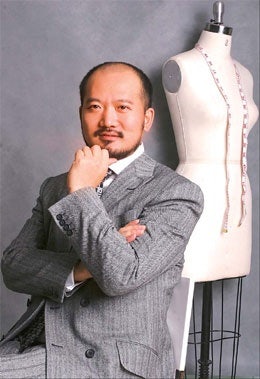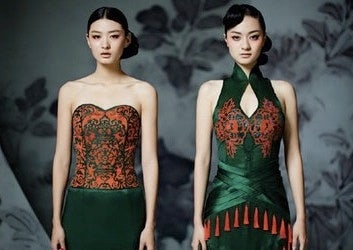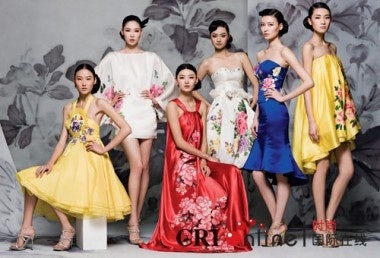Zhang Zhifeng Discusses China's Centuries-Long Love Affair With Luxury, From The Silk Road To Nanjing Road#

This week, at the Prestige Brands Forum in Shanghai, the China-Europe International Business School (CEIBS) discussed the current opportunities and challenges in the Chinese luxury industry with Zhang Zhifeng, founder and Chief Art Director of NE-TIGER (previously on Jing Daily), one of the country's fastest-growing fashion houses. According to Zhang, if they are to compete with the dominant western luxury brands, Chinese luxury goods brands need to be bold enough to break with the prevailing fashion order and create and play by their own rules.
Below is an interview with NE-TIGER's Zhang Zhifeng conducted at the conference:
The media call you "The pioneer of the Chinese luxury brand industry". As the first person in China to establish a luxury brand enterprise, what are the major difficulties and challenges you have encountered over the past 2 decades? What kind of advice or suggestions could you give to your counterparts in the industry?#
I started my business in 1982 and founded the brand of NE.TIGER in 1992 - now it's been 28 years. For many years, I have been the first one in China to have built not only a luxury brand but also a guideline or a theory in the field as well as to have put it into practice. Meanwhile, I have been sharing my experience with my counterparts in the industry. As a Chinese proverb says, "It takes a decade to sharpen a sword".
In each of these passing decades, we have walked, along with our nation, a path from self-awakening to self-sufficiency, and from independence to prosperity. Accompanied by the peaceful emergence of the Chinese nation, we are now embracing with confidence a new era of renaissance and revitalization in Chinese luxury civilization: that is the revitalization of the ancient Chinese luxury civilization and the development of Chinese luxury brands.
Since the birth of NE.TIGER, we have pursued a course of dedicated study and research into the history and the culture of the luxury goods both in the East and the West. During the process, we found it is evident that the history of luxury goods in China dates back a very long time, and we might even say that China once conquered the world with its luxury products. I give you three examples: the first, in 139 B.C., the Silk Road established by ZHANG QIAN during the Han Dynasty extended into Persia, brought fine and exquisite Chinese silks as far as the Roman Empire, the center of Europe of the time, which was regarded as the lead of fashion. The second example is dated 1800 years ago. China in the TANG dynasty was not only the political, economic, and cultural center of the world, but also the center of fashion, as we can see today from how ladies were dressed in ancient frescoes and stone sculptures, indicating the splendid and open culture of fashion in the TANG Dynasty. We can even find many of its reflections and influence in evening gowns nowadays.
My last example: in the MING Dynasty, the years between 1405 to 1433, ZHENG HE, sent by the Chinese government, voyaged 7 times to the West with hundreds of boats full of Chinese silk, Yun brocade, jade, China, tea and other renowned Chinese luxury products given as gifts to the world where they went. It was the peak time of the 'Silk Road of the Sea'. That not only showed the grace of a Chinese nation of courtesy but also illustrated how China contributed to the culture and tradition of the appreciation and the consumption of luxury goods in the west.

Unfortunately, the Chinese feudal system restricted the birth of luxury brands as opposed to luxury products, and as a result of the lost opportunity of the industrial revolution it was only very recently that China started the development of luxury goods through building brands and enterprises.
As far as our challenge and difficulty is concerned, through the 30 years since the beginning of the reform in China, like the sea opening itself to the inflow of hundreds of rivers, many foreign luxury brands have entered into the Chinese market rapidly. To their great satisfaction, all those brands have not only encountered in China the best opportunities they have ever seen for one century or two - since their birth in their own home markets - but also they have been granted privileged status and super-super-national treatment by Chinese, which never happened to them elsewhere. They come here to invade cities and to occupy the land, to grab the market and to pan for gold in our prosperity.
Meanwhile, some high-end shopping malls and department stores in major Chinese cities, for the sake of their own short-term interest, are willing to open the doors and to bow down themselves in front of foreign luxury brands by offering many privileges. For instance, foreign brands are always offered considerable discounts, the best locations, extended rent exemptions for a couple of years, covering cost for store renovation of the openings, reduced fees, etc. - all of these contribute to their rapid expansion in China. I cite here an example of a well-known western luxury brand. In a famous commercial avenue in Beijing, within 300 meters, it opened 3 stores in the past 2 years, at nearly zero cost.
However in contrast, most new-born Chinese luxury brands are not treated fairly here and have to operate under considerable restrictions. Moreover, in the markets where there is only market reform and no market openings such as in the US and in Europe, we experience actual discrimination. In spite of all these facts, we take pride in the passion, loyalty, recognition and support of our customers. We believe that as our brands grow such difficulties will be just temporary, and with the cultivation of our brands, we can transform the challenges that we face into opportunities.
Chinese luxury brands have global vision and our major advantage is that we have our roots in our 5000-year civilization. However, it's not enough. We should apply our innovation on it, in order to give it a new life. The advice I would like to give to my counterparts is that, I think Chinese luxury brands should be bold enough to challenge and to overcome the established centers of influence, to establish new rules, and to create new leadership in the industry.
The huge potential of the Chinese market has attracted more and more attention from global luxury brands. They are entering into the Chinese market with more and more Chinese elements (Such as Chanel holding its fashion show in Shanghai). Some even started to build their own Chinese brand (such as "Shang-Xia " of Hermes) by hiring local Chinese designers. Compared with these experienced luxury brands, what kind of advantage do you have, to build up a Chinese luxury brand?#
Europe became the first tier for luxury goods consumption within one or two centuries. The US became the second tier for luxury goods consumption after the Second World War within 50 years as the biggest economic force in the world. In the recent 30 years, with a developed Japan and an emerging China, East Asia is nowadays the third tier for luxury goods consumption. Despite the global recession of luxury goods consumption, China has a yearly growth rate of 20% to 30%. Currently, the consumption of luxury goods in China occupies 25% of global consumption, surpassing the US and becoming the top second nation in luxury goods consumption. The Chinese market is attracting the world's attention.

The European brands which we are familiar with, such as Hermes or Louis Vuitton, have a brand history not more than 200 years, and Chanel, Dior, Armani, Versace and Dolce & Gabbana have a history less than 100 years. Today, in the context of the globalization of the economy and the integration of information technologies, as well as a prosperous luxury goods consumption market, China can take much less time in building its own luxury brands, demonstrating another legend to the world.
Besides, based on the market potential of billions of population, based on China's 5000 years of civilization and its cultural heritage of Confucianism, Buddhism and Taoism, and based on the passion and creativity of the new Chinese generation of designers, I believe in our future in the Chinese luxury brand industry.
Most foreign luxury brands mainly have their origins in a talented designer or craft person, by offering customers some products fulfilling the need of the time, with excellent quality. This is how their products got popular and got recognized as an icon of the brand in the luxury industry. For example, trench coats from Burberry and its Equestrian Knight label. Chanel dresses and double C label, shoes and scarves of Ferragamo and its G label, etc. However until today, there is not yet any Chinese designer who can lead such a kind of vogue in the world. How do you see this phenomenon?#
As time passed by, the expectation and demand of luxury goods consumers evolved. Nowadays, a noticeable LOGO on a luxury product is not enough to match with consumers' social identity and status. They are paying more attention to, not only outstanding manufacturing and excellent service, but also appealing philosophy, value, culture and lifestyle that a luxury brand implies. More and more brands have gone beyond their distinctive LOGOs or patterns, and started to seek fashionable, personalized and artistic design in their new products, in order to fulfill consumers' needs. To demonstrate the luxury in low-profile and to interpret a unique taste is the main trend of today's luxury brand industry.
In the age of globalization, the fusion of cultures has reached a new level. And our design concept of "Combination of the ancient and the modern, melting the East and the West" is in the trend. Such as Hua Fu of NE.TIGER, which represents the national dress of China, has become a symbol for Chinese spirit. Hua Fu takes "courtesy" as spirit, "Yun brocades" as material, Chinese embroideries as techniques, Chinese national colors as body. It has characteristics to symbolize, to be classic, to reflect the fusion and compatibility of races & minorities and to represent modernity. Hua Fu is regarded as the inheritor of Chinese civilization and we hope that it carries and spreads Chinese luxury civilization to the places in world where it will lead a trend.
In which industry do you think a world influential enterprise in the luxury brand industry will be born in China?#
China used to be the major manufacturer of the world garment industry, and now becomes a nation also full of creativity and design capacity. Some Chinese design can even lead the global trend. Globally speaking, the industry which has a higher chance of bringing a Chinese enterprise with the world leading luxury brands must be the fashion industry, such as Chinese haute couture, which carries and reflects the rich Chinese culture background.
In 2006, I described my theory of "the renaissance and revitalization of the Chinese luxury brand industry", as well as my prospects for its bright future. Up to now, we passed through globally eye-catching events such as the Beijing Olympics, 60th anniversary of the P.R.C. and we are looking forward to the Shanghai Expo very soon. The whole world is looking at the East, and more precisely at China in the East.
I believe the time of the revitalization of the Chinese luxury brand industry has arrived and worldwide influential Chinese luxury brands are arising!